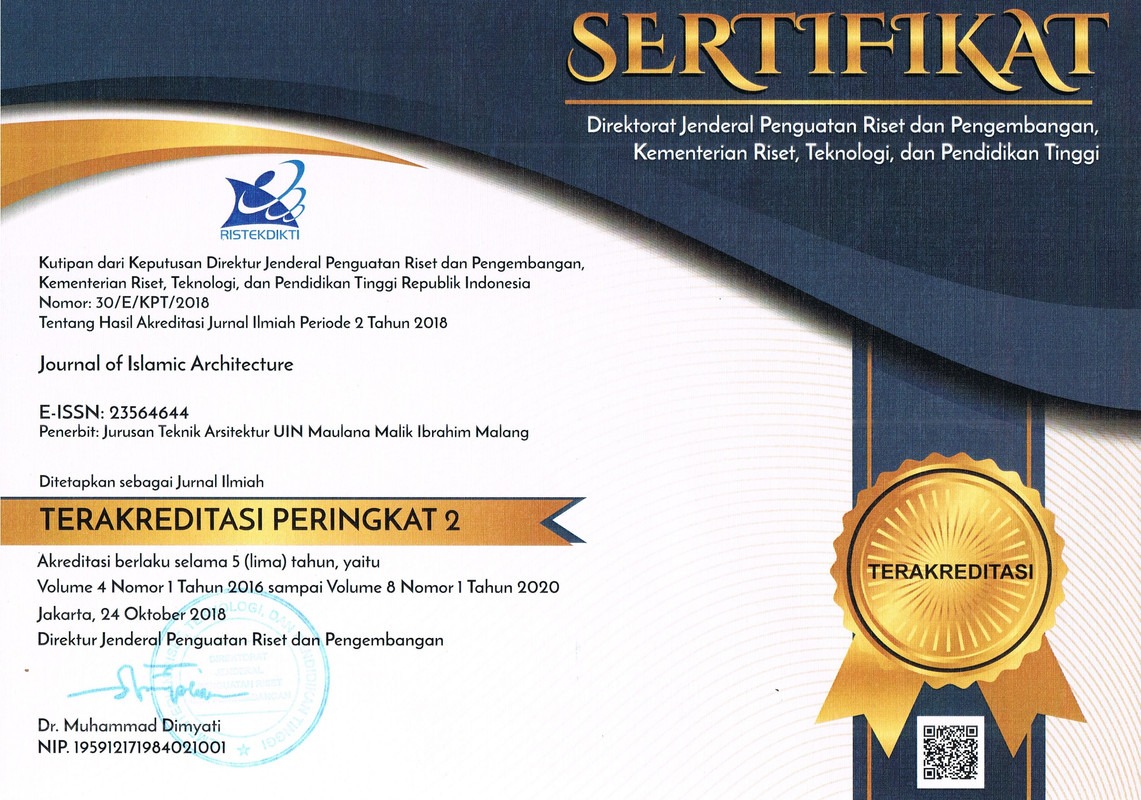THE FACTORS CONTRIBUTING IN SPIRITUALITY DEFINITION OF IRANIAN MOSQUES
Abstract
Islamic mosques in Iran, similar to other Islamic nations, are reflections of visual beauties and typical examples of symbolic integration and relationship with strong beliefs and geometry. Scrutiny of these relationships provides a broader and profound perception of the design paradigm of these sacred masterpieces, which not only have been responding to the functional aspect of holy places but also represent an aesthetic model of architectural geometric perfection. This paper aims to survey this paradigm with a focus on its basic concepts and geometric origins; in this regard, it seeks to address the ensuing questions: what are the fundamental ideas in the design of mosques? How and which methods were used have been reflected in the architecture of mosques? How has the geometry assisted the architecture of mosques? What is the geometry role in the accomplishment of those basic concepts? To this end, after stating the fundamental concepts and dominant ideology in the design of mosques and the progress factors of Islamic architecture, their architectural features, spatial organization, and relations with geometry had been examined. The research hypothesis is that monotheism and divine unity are the original concepts of the architecture of mosques and this type of architectural design tries with the help of a range of abstract arts, symbolic materials, various methods, and science of geometry symbolize these ideas to create a sacred atmosphere and place which could be an intermediate spot for the human to achieve that divinity and unity.
Keywords
Full Text:
PDFReferences
A.KHAKI, and A. S. H. ABAD, "The Essence of Islamic Architecture of Mosques: a Reflection on the Spiritual Identity and Sacred Suppositions," Cumhuriyet Science Journal 36, no. 4, pp. 2314-2321, 2015.
Torabiyan, Mohammad, and K. M. Nejad. "islamic Architecture and its Challenges." World Academy of Science, Engineering and Technology, International Journal of Civil, Environmental, Structural, Construction and Architectural Engineering 8, no. 2, pp.238-241, 2015.
A.N.Ebrahimi, and M. Aliabadi, "The Role of Mathematics and Geometry in Formation of Persian Architecture," Asian Culture and History 7, no. 1 , pp. 220, 2014.
P.Farazmand, and H. S. Sarbangholi, "Investigating the Patterns of Islamic Architecture in Architecture Design of Third Millennium Mosque," European Online Journal of Natural and Social Sciences: Proceedings 3, no. 4 (s), pp-501, 2015.
S.H. Loumer, QURANIC THEMES AND REFLECTIONS IN ISLAMIC ART AND ARCHITECTURE.
A.Hosseini, "Heuristic Analysis in Architecture of Aqa-Bozorg Mosque-School in Qajar Dynasty," Journal of Islamic Architecture 4, no. 2, pp. 70-76, 2016.
S.M.Adi and C. Puspitasari, "Mosque as a Model of Learning Principles of Sustainable Architecture," Journal of Islamic Architecture 4, no. 1 , pp. 33-36, 2016.
N. Utaberta, M.D. Niya and A.B. Sabil, "UNIVERSAL DESIGN AND ACCESSIBILITY FOR PEOPLE WITH DISABILITIES IN MASJID NEGARA, MALAYSIA," Journal of Islamic Architecture 4, no. 4, pp. 134-138, 2017.
D.Dewiyanti and B.S. Budi, "The Salman Mosque: The Pioneer of the Mosque Design Idea, the Driving Force Behind the Coinage of the Term ‘Campus Mosque’in Indonesia," Journal of Islamic Architecture 3, no. 4, pp. 143-153, 2016.
J. Zibafar, "Vacuum and Creation of Spiritual Space". Tehran: 2006.
Z. S. Sheijani, S. S. Sheijani and M. Khakpour, "A Review on the Concepts of Traditional Architecture by Mulla Sadra’s Al-Hikmat Al-Mota'alie," Journal of Islamic Architecture 4, no. 4, pp. 146-153, 2017.
H. Nadimi, "The fact of pattern " A set of paper at Symposium on mosque Architecture, no.1, 2005.
M. H. Khademnezhad, Historical Mosque of Yazd. Yazd: Culture Heritage and tourism organization, 2005.
O. S. Asfour, "Bridging the Gap Between the Past and the Present: a Reconsideration of Mosque Architectural Elements," Journal of Islamic Architecture 4, no. 2, pp. 77-85, 2016.
S.Omer, "Rationalizing the Permissibility of Mosque Decoration," Journal of Islamic Architecture 4, no. 1 , pp. 14-26, 2016.
W. S. Sahabuddin, "Dome Form Typology Of Islamic Architecture In Persia," Journal of Islamic Architecture 4, no. 4, pp.163-167, 2017.
B. Molodi, Application of geometry in Architecture of Iran's past. Tehran: Building and housing research center, first print, 2002.
M.Mahdavinejad, S.A. Siyahrood, M.Ghasempourabadi, and M. Poulad, "Development of Intelligent Pattern for Modeling a Parametric Program for Public Space (Case study: Isfahan, Mosalla, Iran)," In Applied Mechanics and Materials , Trans Tech Publications, Vol. 220, pp. 2930-2935, 2012.
P.A. Johnson, The Theory of Architecture: Concepts Themes & Practices, John Wiley & Sons, pp. 357, 1994.
J. A. MC Mahon, "Beauty," in the Rutledge companion to Aesthetic, berys Gout and Dominic, pp. 227-8, 2001.
M. Tavasoli, Art of Geometry. Tehran: Payam, first print , pp. 5-15. 2004.
S. Ahmed, "The Spiritual Search of Art Over Islamic Architecture with Non-figurative Representations," Journal of Islamic Architecture 3, no. 1, pp.1-13, 2014.
S. A. Siyahrood, A. Ebrahimi, M. Mahdavinejad, "Generating a Functional Grammar for Architectural Design from Structural Hierarchy in Combination of Square and Equal Triangle." World Academy of Science, Engineering and Technology, International Science Index, Architectural and Environmental Engineering, 11(12), 2015.
E. Sayid, Geometric pattern in Islamic art. Tehran: Islamic Republic of Iran Broadcasting, 1984.
M.Hocine and N. C. Chemrouk, "Reuse Of Djenane Abd-El-Tif, An Emblematic Islamic Garden In Algiers," Journal of Islamic Architecture 3, no. 3, pp.135-142, 2015.
M. Morovvat, Home Celestial. Tehran: Civil of new city, 2005.
DOI: https://doi.org/10.18860/jia.v5i4.5254
Refbacks
- There are currently no refbacks.






